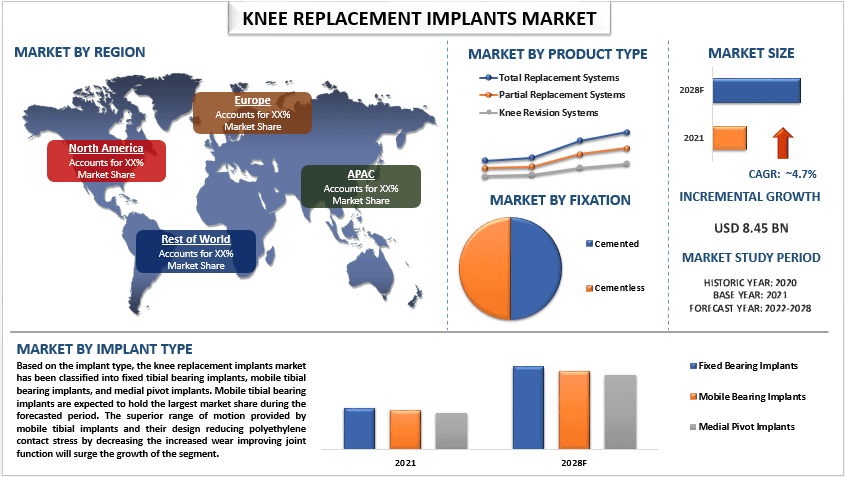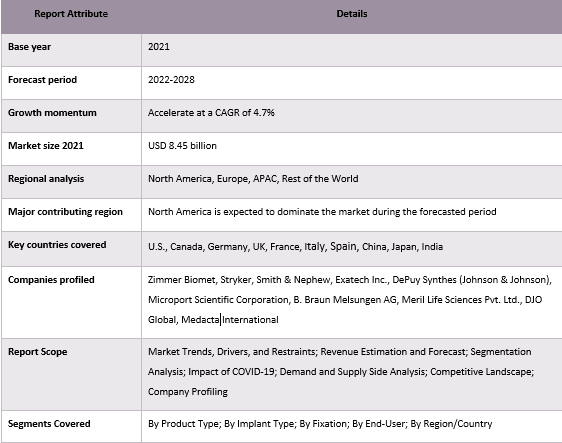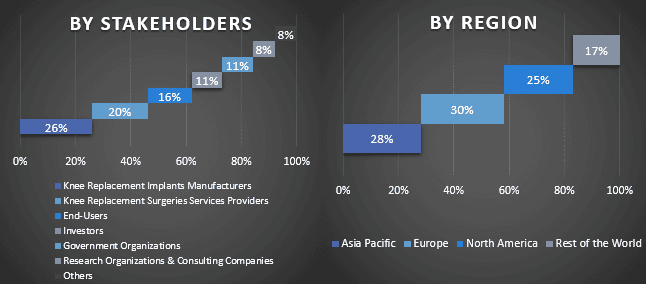膝関節置換インプラント市場:現状分析と予測(2022年~2028年)
製品タイプ(全置換システム、部分置換システム、膝関節再置換システム); インプラントタイプ(固定ベアリングインプラント、モバイルベアリングインプラント、内側ピボットインプラント); 固定方法(セメント固定およびセメントレス固定); エンドユーザー(病院、整形外科クリニックなど); 地域/国に重点を置いています。

膝関節置換インプラント市場は、高齢者人口の増加、変形性関節症、関節リウマチ、乾癬性関節炎などの様々な膝関連筋骨格系疾患の有病率の上昇により、予測期間中に約4.7%の力強いCAGRで成長すると予想されています。
膝関節置換インプラントは、損傷または疾患のある膝関節を人工関節に置き換えるために膝関節置換手術で使用される医療機器です。膝関節置換手術は、通常、変形性関節症、関節リウマチ、または怪我などの状態により、重度の膝の痛みと可動域の制限がある患者に行われます。膝関節置換手術は、損傷または疾患のある膝関節の一部を切除し、人工関節に置き換える大規模な手術です。膝関節置換インプラント市場は常に進化しており、膝インプラントの性能と寿命を向上させるための新しい高度な技術が開発されています。これにより、より新しく高度なインプラントの需要が増加しています。例えば、2021年7月、DePuy Synthesは、病院と外科医が患者の転帰を改善し、オーストラリアのヘルスケアシステムの持続可能性を高めるのに役立つ、ロボット支援膝手術ソリューション「VELYS」をオーストラリアで発売しました。VELYSは、全膝関節置換術のための同社のATTUNE Knee Systemとともに使用することを目的としています。
市場で活動している主要なプレーヤーには、Zimmer Biomet、Stryker、Smith & Nephew、Exatech Inc.、DePuy Synthes (Johnson & Johnson)、Microport Scientific Corporation、B. Braun Melsungen AG、Meril Life Sciences Pvt. Ltd.、DJO Global、Medacta Internationalが含まれます。これらのプレーヤーは、ハイテクで革新的な製品/技術で顧客を容易にするために、いくつかのM&Aがパートナーシップとともに実施されています。
レポートで提示される洞察
「製品タイプの中で、部分置換システムセグメントは予測期間中に大きなCAGRを示すでしょう」
製品タイプに基づいて、市場は全置換システム、部分置換システム、および膝関節再置換システムにセグメント化されています。これらのうち、部分置換システムセグメントは、予測期間中に大きなCAGRを示すでしょう。これは、膝関節全体ではなく、損傷した部分のみをインプラントと置き換えるためです。部分置換システムは、通常、膝関節の一部のみに影響を与える変形性関節症またはその他の変性疾患のある患者に推奨されます。部分置換システムは、切開が小さく、骨の除去が少ないため、全膝関節置換術よりも侵襲性の低い手術です。これにより、痛みが軽減され、入院期間が短縮され、患者の回復時間が短縮されます。
「インプラントタイプの中で、固定ベアリングインプラントセグメントは予測期間中に大きなCAGRを示すでしょう」
インプラントタイプ別に、市場は固定ベアリングインプラント、可動ベアリングインプラント、および内側ピボットインプラントにセグメント化されています。これらのうち、固定ベアリングインプラントセグメントは、予測期間中に大きなCAGRを示すでしょう。固定ベアリングインプラントは、膝関節に良好な安定性を提供し、患者の歩行、起立、および日常活動の実行能力を向上させることができます。固定ジョイントは、インプラントのずれや回転を防ぎ、不安定性や脱臼につながる可能性があり、それによって膝関節置換インプラント市場の成長に貢献します。
膝関節置換インプラント市場レポートの対象範囲

「北米は2021年に膝関節置換インプラント市場を支配しました」
北米は、この地域における高度なヘルスケアシステムの存在とヘルスケア支出の増加により、2021年に膝関節置換インプラント市場を支配しました。さらに、適切な償還ポリシーが推進要因です。さらに、過去10年間からの関節形成術の急増も、この地域の膝再建および置換デバイスの市場を拡大すると予測されています。American Joint Replacement Registryの2020年年次報告書によると、約995,410件の全膝関節形成術が実施され、2012年から2019年の間に75,489件の膝再置換関節形成術が実施されました。
このレポートを購入する理由:
- この調査には、認証された主要な業界専門家によって検証された市場規模と予測分析が含まれています。
- このレポートでは、業界全体のパフォーマンスの概要を一目で確認できます。
- このレポートでは、主要なビジネス財務、製品ポートフォリオ、拡張戦略、および最近の動向に焦点を当てて、著名な業界ピアの詳細な分析を取り上げています。
- 業界に蔓延する推進要因、制約、主要な傾向、および機会の詳細な調査。
- この調査では、さまざまなセグメントにわたる市場を包括的にカバーしています。
- 業界の地域レベル分析への深い没頭。
カスタマイズオプション:
世界の膝関節置換インプラント市場は、要件またはその他の市場セグメントに応じて、さらにカスタマイズできます。これに加えて、UMIは、お客様独自のビジネスニーズがあることを理解しているため、お客様の要件に完全に適合するレポートを入手するために、お気軽にお問い合わせください。
目次
膝関節置換インプラント市場分析(2022年~2028年)の調査方法
世界の膝関節置換インプラント市場の過去の市場を分析し、現在の市場を推定し、将来の市場を予測することは、主要地域における膝関節置換インプラントの採用状況を調査・分析するために実施された3つの主要なステップでした。過去の市場数値を収集し、現在の市場規模を推定するために、徹底的な二次調査が実施されました。次に、これらの洞察を検証するために、数多くの調査結果と仮定が考慮されました。さらに、世界の膝関節置換インプラント市場のバリューチェーン全体にわたる業界の専門家との徹底的な一次インタビューも実施されました。一次インタビューを通じて市場数の仮定と検証を行った後、完全な市場規模を予測するためにトップダウン/ボトムアップアプローチを採用しました。その後、業界に属するセグメントとサブセグメントの市場規模を推定および分析するために、市場の内訳およびデータ三角測量法が採用されました。詳細な方法論は以下に説明します。
過去の市場規模の分析
ステップ1:二次情報源の詳細な調査:
年次報告書および財務諸表、業績プレゼンテーション、プレスリリースなどの企業内部情報源、および学術誌、ニュース&記事、政府刊行物、競合他社の刊行物、セクターレポート、サードパーティデータベース、およびその他の信頼できる刊行物などの外部情報源を通じて、膝関節置換インプラント市場の過去の市場規模を取得するために、詳細な二次調査が実施されました。
ステップ2:市場セグメンテーション:
膝関節置換インプラント市場の過去の市場規模を取得した後、主要地域のさまざまなセグメントとサブセグメントに関する過去の市場の洞察とシェアを収集するために、詳細な二次分析を実施しました。主要なセグメントは、製品タイプ、インプラントタイプ、固定方法、エンドユーザーとしてレポートに含まれています。さらに、その地域における膝関節置換インプラントの全体的な採用状況を評価するために、国レベルの分析が実施されました。
ステップ3:要因分析:
さまざまなセグメントとサブセグメントの過去の市場規模を取得した後、膝関節置換インプラント市場の現在の市場規模を推定するために、詳細な要因分析を実施しました。さらに、膝関節置換インプラント市場の製品タイプ、インプラントタイプ、固定方法、エンドユーザーなどの従属変数および独立変数を使用して要因分析を実施しました。世界中の膝関節置換インプラント市場セクターにおけるトップパートナーシップ、M&A、事業拡大、製品発売を考慮して、需要と供給側のシナリオについて徹底的な分析を実施しました。
現在の市場規模の推定と予測
現在の市場規模の算出:上記の3つのステップからの実用的な洞察に基づいて、現在の市場規模、世界の膝関節置換インプラント市場の主要なプレーヤー、およびセグメントの市場シェアに到達しました。必要なすべてのパーセンテージシェア分割と市場内訳は、上記の二次アプローチを使用して決定され、一次インタビューを通じて検証されました。
推定と予測:市場の推定と予測のために、利害関係者が利用できる推進要因とトレンド、制約、機会を含むさまざまな要因に重みが割り当てられました。これらの要因を分析した後、適切な予測手法、つまりトップダウン/ボトムアップアプローチを適用して、世界の主要市場全体のさまざまなセグメントとサブセグメントについて、2028年の市場予測に到達しました。市場規模を推定するために採用された調査方法論には、以下が含まれます。
- 収益(米ドル)の観点から見た業界の市場規模と、国内の主要市場全体での膝関節置換インプラント市場の採用率
- 市場セグメントとサブセグメントのすべてのパーセンテージシェア、分割、および内訳
- 提供される製品の観点から見た、世界の膝関節置換インプラント市場の主要プレーヤー。また、急速に成長している市場で競争するためにこれらのプレーヤーが採用した成長戦略
市場規模とシェアの検証
一次調査:主要地域全体のトップレベルのエグゼクティブ(CXO/VP、営業責任者、マーケティング責任者、オペレーション責任者、地域責任者、国責任者など)を含む主要なオピニオンリーダー(KOL)との詳細なインタビューが実施されました。次に、一次調査の結果が要約され、述べられた仮説を証明するために統計分析が実行されました。一次調査からの入力は二次調査の結果と統合され、情報が実用的な洞察に変わりました。
さまざまな地域における主要参加者の分割

市場エンジニアリング
データ三角測量法は、全体的な市場推定を完了し、世界の膝関節置換インプラント市場の各セグメントおよびサブセグメントの正確な統計数値を導き出すために採用されました。データは、世界の膝関節置換インプラント市場における製品タイプ、インプラントタイプ、固定方法、およびエンドユーザーの分野におけるさまざまなパラメーターとトレンドを調査した後、いくつかのセグメントとサブセグメントに分割されました。
世界の膝関節置換インプラント市場調査の主な目的
世界の膝関節置換インプラント市場の現在および将来の市場動向が調査で特定されました。投資家は、調査で実施された定性的および定量的分析に基づいて、投資に関する裁量を決定するための戦略的な洞察を得ることができます。現在および将来の市場動向は、地域レベルでの市場の全体的な魅力を決定し、産業参加者が未開拓の市場を活用して先行者利益を得るためのプラットフォームを提供しました。調査のその他の定量的な目標は次のとおりです。
- 価値(米ドル)の観点から見た膝関節置換インプラント市場の現在および予測される市場規模を分析します。また、さまざまなセグメントおよびサブセグメントの現在および予測される市場規模を分析します
- 調査のセグメントには、製品タイプ、インプラントタイプ、固定方法、およびエンドユーザーの分野が含まれます
- 膝関節置換インプラント業界の規制の枠組みを定義および分析します
- さまざまな仲介業者の存在に伴うバリューチェーンを分析するとともに、業界の顧客と競合他社の行動を分析します
- 主要地域における膝関節置換インプラント市場の現在および予測される市場規模を分析します
- レポートで調査された地域の主要国には、アジア太平洋、ヨーロッパ、北米、およびその他の地域が含まれます
- 膝関節置換インプラント市場の企業プロファイル、および市場のプレーヤーが急速に成長している市場で維持するために採用した成長戦略
- 業界の深掘り地域レベルの分析
関連 レポート
この商品を購入したお客様はこれも購入しました










